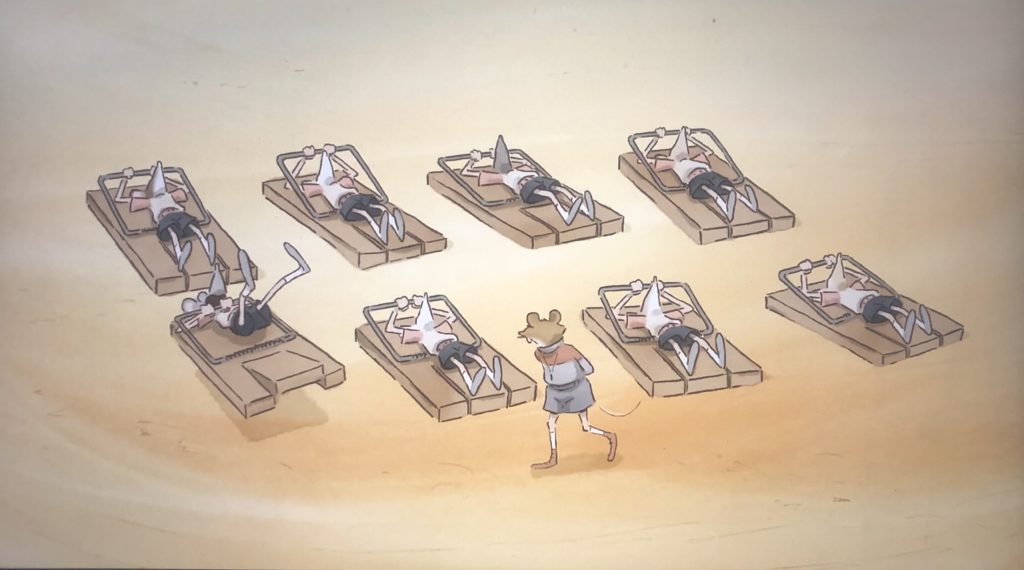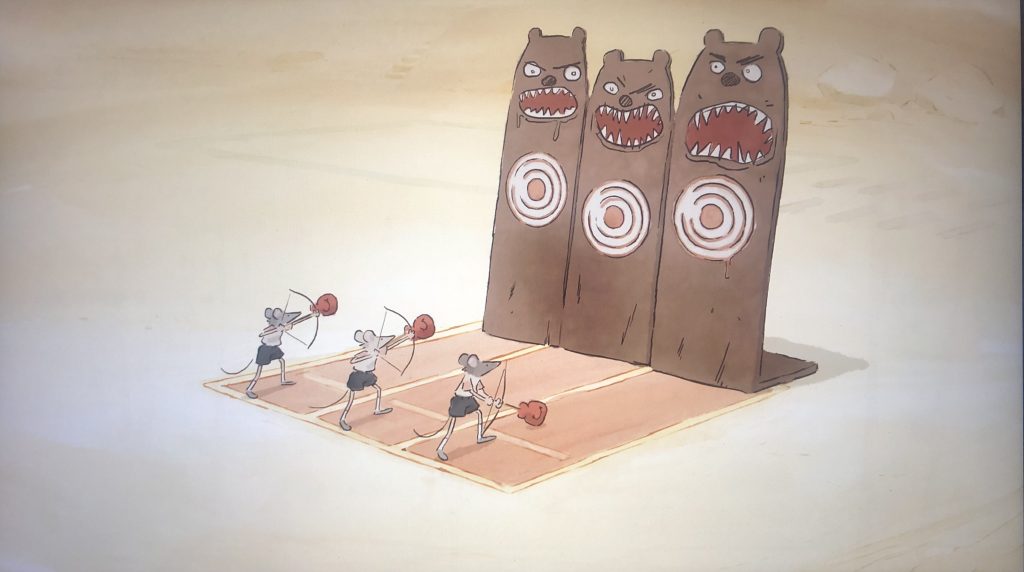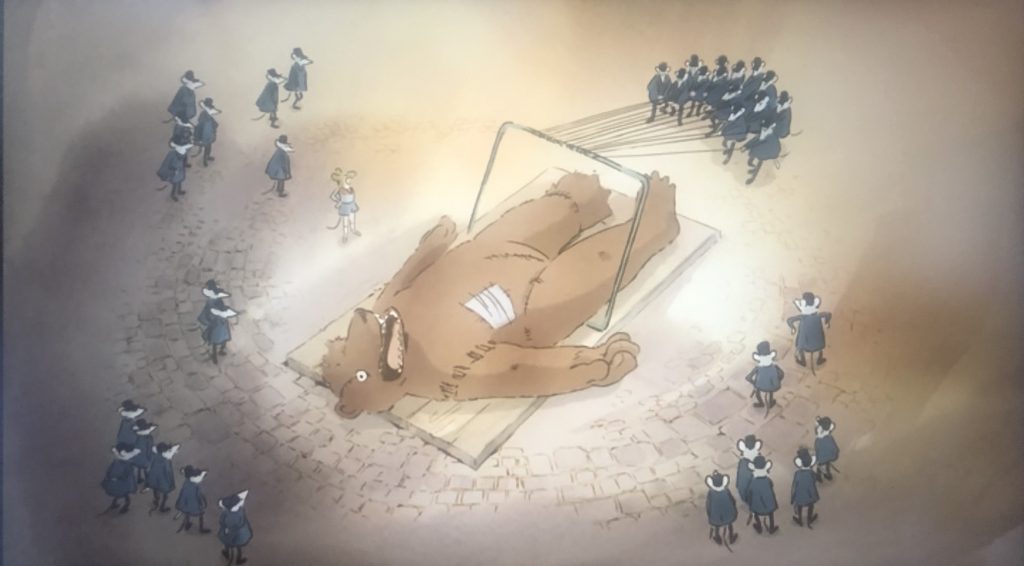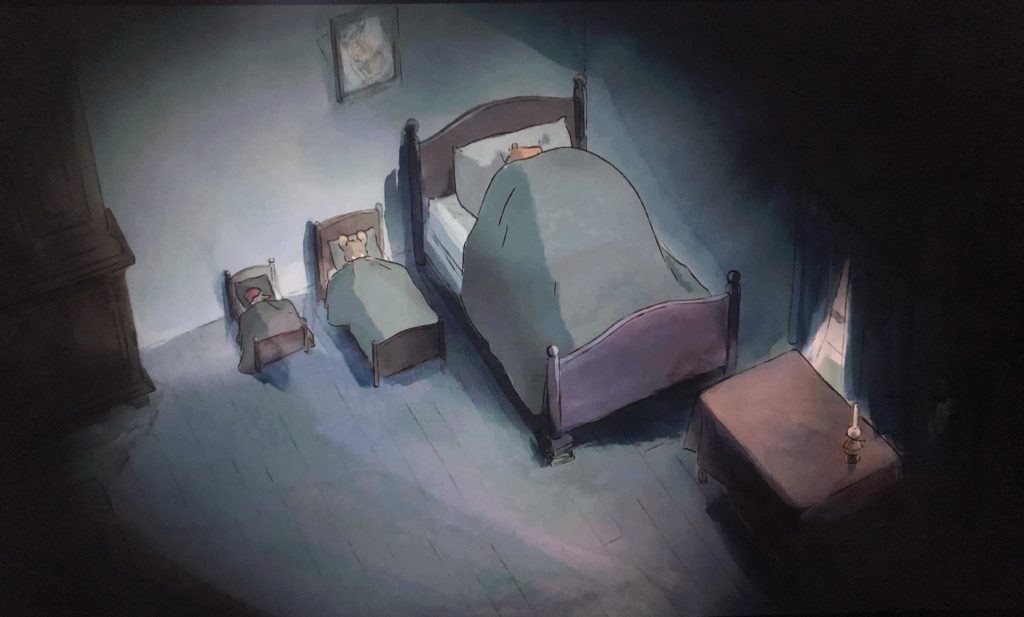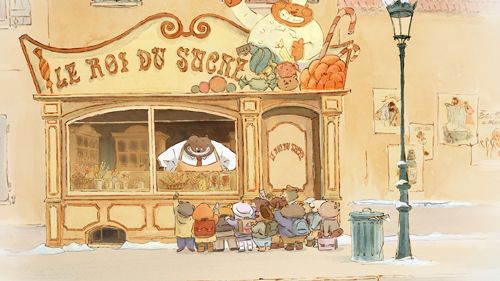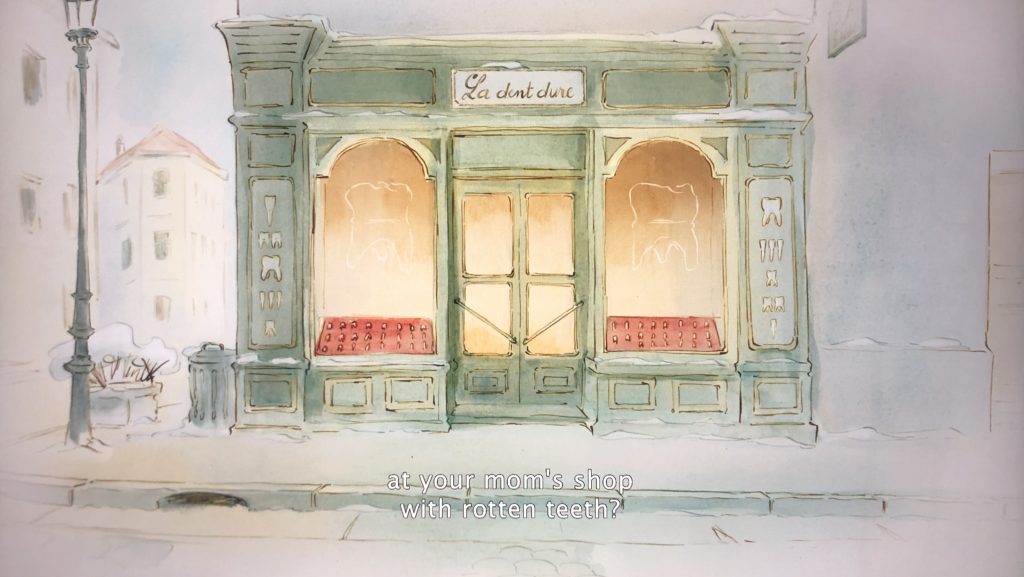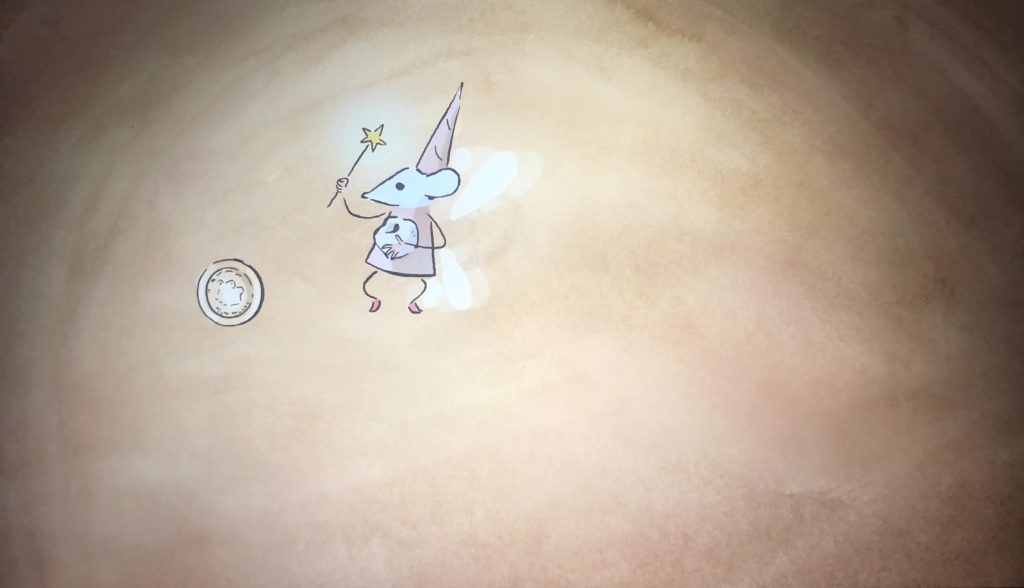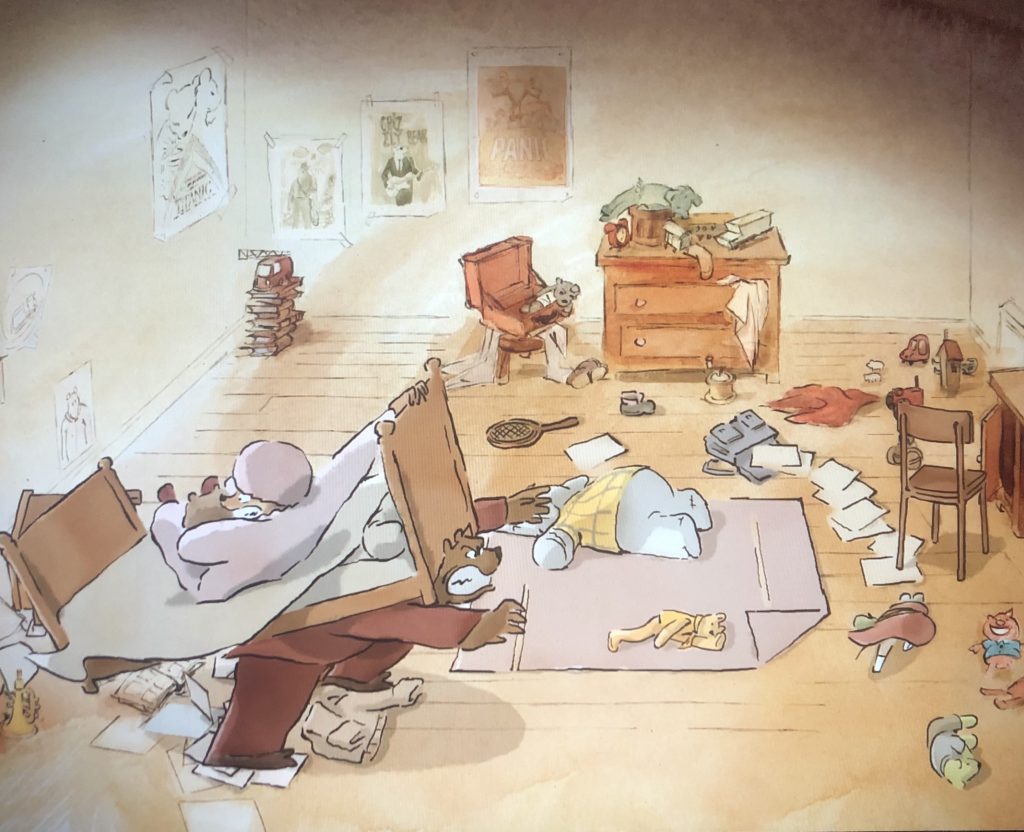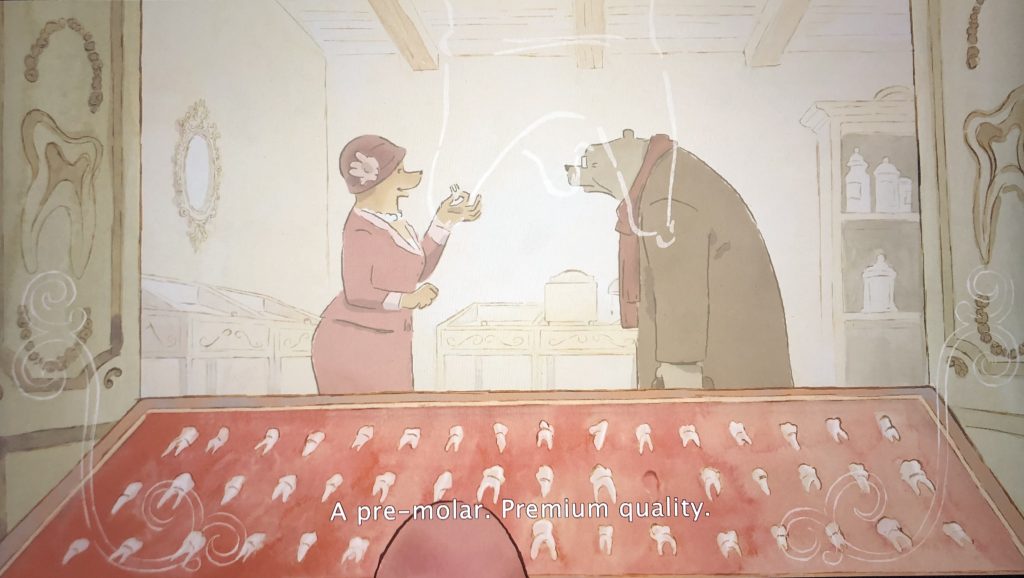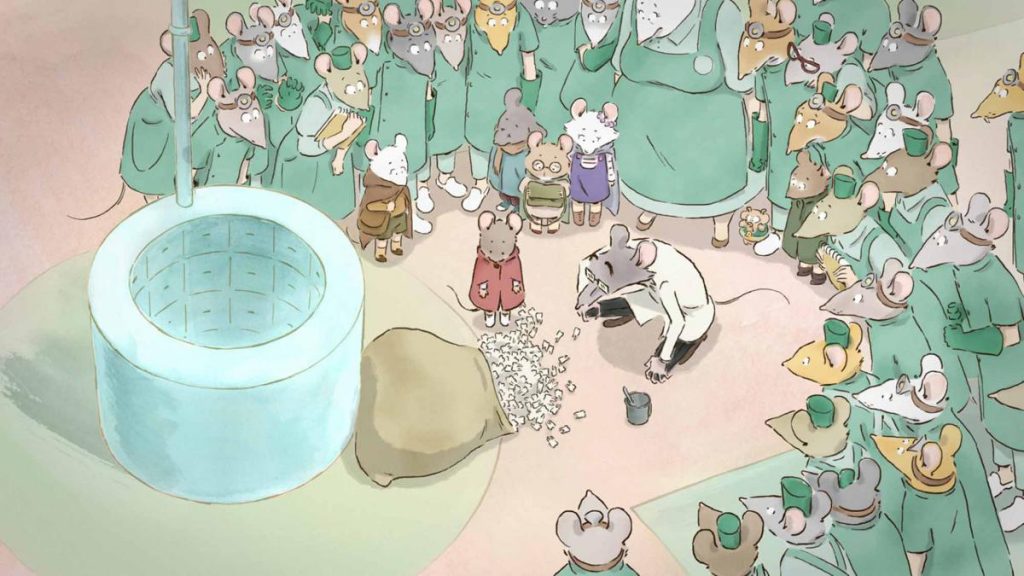Ernest and Celestine[2] (2012) is a French animated film that presents the unorthodox relationship between a bear and a mouse. Introduced as a struggling musician, Ernest is starving and on the hunt for food; Celestine is on the hunt for teeth when they form an unlikely pairing to help one another. Due to societal constraints and animal stereotypes, they are treated as criminals for spending time together consequently hiding from the law: – “it’s all wrong […] a bear and a mouse can’t be together”2. In isolation, Ernest and Celestine uncover their dreams which reject the expectations of society, there is an increased focus on the beauty of nature and the aesthetic artistic muse. Ernest’s music inspires Celestine’s paintbrush, the notes coinciding with the colours to suggest that a society can be better when acknowledging repelling forces. The action predominantly occurs on the road ‘Rue Ernestine’ which as a blend of Ernest and Celestine foreshadows the acceptance of their relationship.
Through depicting species contrasts in the counter societies, the protagonists’ relationship becomes significant in the indication of merging social classes and overcoming prejudiced attitudes towards integration. Renner’s illustrations convey traces of Marxist undertones to offer a socio-political examination, the ideologies of capitalism and exploitation of workers accentuating a resonance to the contrasting societies. Renner underlines Marxist notions of capitalism and exposes the segregation between the animals as the bourgeoisie and the proletariat. The emphasis on the class hierarchy highlights the issues prevalent within society and is immediately suggested in Ernest singing on the streets about starving to death. In the denouement court scene, Celestine shouts “he was dying of hunger, you want the poor to die of hunger? As fat as all of you are”2 which exposes the greed of the upper class through notions of gluttonous excess as a critique on exploitation of the class system which historically fuelled the French Revolution, though further the blazing trial results in their freedom and the criminal charges are dismissed. Marxism is reflected across the illustrations and animal representations to explore the human society and the exploitative treatment of animals from afar.
Anthropocentrism Animal Exploitation.
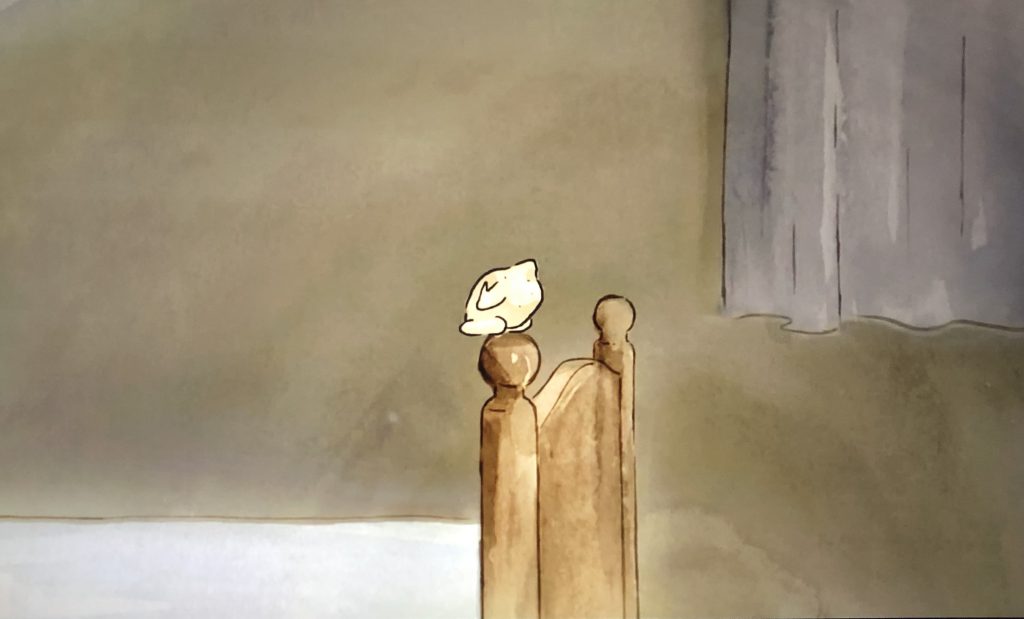
Ernest lives in a crumbling house, he is aggressive and licks his lips at the thought of food to reinforce bear stereotypes as bestial and ravenous. A lack of material possessions and food induces a hallucinatory vision of the bird as a comedic interpretation on food, a mockery on the anthropocentric view of animal farming. The bird metamorphosizes into a traditional cartoon to expose the human exploitation that uses animals for meat and consumerism. The mise-en-scene accentuated by the aesthetically paling watercolour illustrations suggests a state of poverty. Irony is depicted when Ernest sings of his hunger and desire for food, he maintains an upbeat tempo even though his environment offers an economic examination – the shops are shut and the streets are lined with more bins than people. The constructs of society are explored in the allegorical representation of the animals, each microcosmic society presents their own bourgeoisie and proletariat structure. Ernest is labelled a criminal “first making noise and now stealing”2, his social status is reduced when he is compared to the other bears who epitomise materialistic wealth and excess.
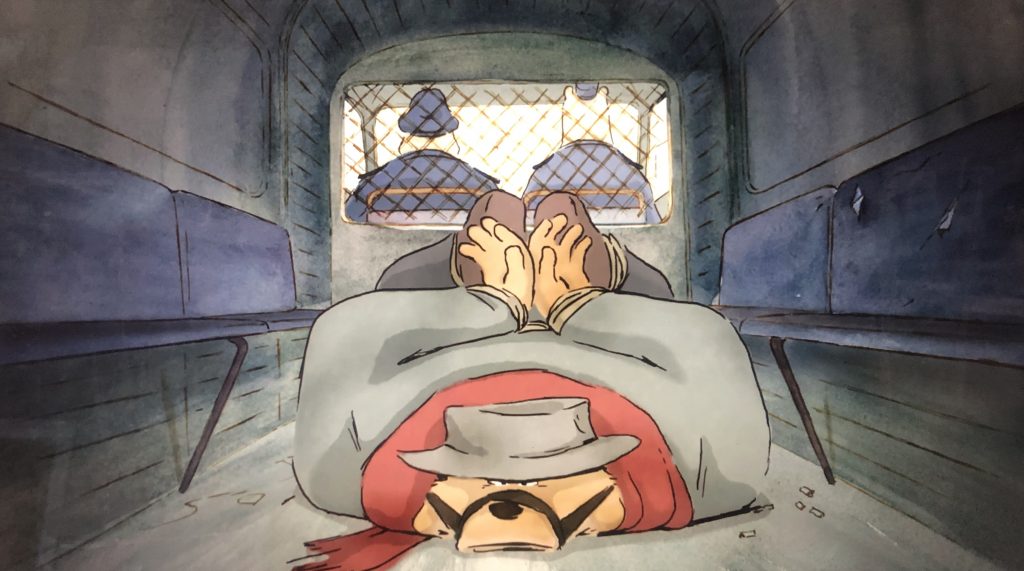
The muzzle is a key symbol in his arrest that conveys animal stereotypes and exposes the anthropocentric maltreatment. Pathos is inspired as the muzzle becomes a power symbol highlighting unethicality and restraining natural impulses. In addition to the muzzle, Ernest is placed in a caged van thus exploring the idea of trapping animals, the bears are reduced to human standards of animal exploitation by displaying maltreatment even within their animal society. In antithesis, the mouse civilisation is presented as inverting the stereotypes of maltreatment, they pose hints of a revolution against anthropocentrism. Mousetraps are used as recreational leisure in the form of weightlifting. Furthermore, archer mice are seen shooting at bear targets to introduce thematic links to traditions of hunting bears for meat and fur. The segregation between the mice and bears in this scene stands for the human-animal dichotomy. A historical examination on the French ‘Terror’ period is conveyed through the guillotine imagery, Ernest and Celestine watch as the authoritarian figures prepare a device of death conceived by humanity, the weapon emphasises a reference to the historical poverty of society and also harnesses themes of animal killing for meat and other profitable, capitalist ventures. The protagonists represent an opposition in every sense: gender, species, size, age – the contradictions stress the disparity of the human-animal divide and the exposure of animal maltreatment imagery expresses the use of animals to portray human society.
The Grey One tells nightmares about ‘Le Grand Mechant’1, her shadow silhouette metamorphosizes into a monster reinforcing the animality norms of bears. Alternatively, as it is her shadow the animation could be suggesting that monsters are prevalent within all societies and not restricted to animalism. Celestine is isolated from the other mice especially considering their reputation in nests. Her drawings depicting interspecies relationships are discarded, even binned to epitomise the disdain for integration – only in fairytales can different species mix. The bedtime story describes bears as savages that “[eat] anything, absolutely anything […including] mice raw and alive”2, the repetition reinforces bear stereotypes as threats in a hyperbolic comedic portrayal. The animals wear clothes suggesting that human ideologies have been imposed upon them thus accentuating the allegory for which the animals represent human society and highlight animal exploitation. The parallel of Celestine’s attire to Little Red Riding Hood coincides with the bedtime story ‘Le Grand Mechant’, the title translates to The Big Bad Bear, a pun on The Big Bad Wolf. The fairytale alludes to animalistic themes and reinforces stereotypes, the viewer hence questioning if Ernest will eat Celestine? In hiding, links to the three bed sizes further fuel the link to an inverted fairytale, by two different species being in the beds it shows that they have deconstructed the traditions.
Capitalism
The lexis and dialogue accelerates the theme of class division and serves to exemplify Marx’s bourgeoisie versus proletariat structure. The establishment of class division is emphasised in the friendship; bears can be seen as the bourgeoisie – Ernest tries to kick Celestine out since “mice are not allowed in the house” thus accelerating class superiority exercised against a differing species. “Bears above and mice down below”2 parallels a physical hierarchy in which the mice are seen as the proletariat, Celestine directly addresses the stereotypical norms and rebels against them: – “but a bear and a mouse […] not what? Not seemly? Not proper?”2. Ernest adheres to social norms and commands Celestine to “stay downstairs, I don’t want to see or hear you”. He reinforces the suppression of the lower class in a social examination.
When analysing the mise-en-scene, the sweet shop symbolises luxury – ‘Le Roi de Sucre’2 meaning ‘The King of Sugar’ highlights an exposure to the social power hierarchy. In conjunction to the sweet-shop, capitalism is highlighted with the tooth shop. ‘La Dent Dure’2 which to an English audience, denture suggests an association to dental procedures, though it also translates to ‘the hard tooth’ acting as a pun on ‘the hard truth’ in exposing capitalist exploitation: – “wealth will come from your fellow bears’ rotten teeth”2. The bear society presents an exploitative society, the family uses a cycle of selling sweets and teeth as commodities in order to retain a profit. Celestine stealing the teeth suggests that she is breaking the capitalist exploitation cycle in order for the survival of her own society. Sweets are an image of luxury therefore conveying themes of greed and consumerism in the capitalist sphere. Ernest enters a dream sequence depicting a fantasyland utopia, one with an excess of sugar. The conversion into a nightmare of mice taking his food ironically exposes bourgeois fears of breaking down class stereotypes, the fears evidently stemming from an internalised flaw of greed.
The owners describe the tooth as a ‘shiny little pearl’ suggesting the monetary essence and commodity value, George conveys the corporate obsession by exclaiming it as ‘the base of [his] capital investments’2. The sequence showing the tooth fairy mouse transforming the ‘pearl’ into a gold coin suggests that mice are the key workers; representing the ‘proletariat’[3] working class, the bears exploit them for capital gain and profit. Leon asks for ‘two quarters’ conveying the ‘capitalist mode of production’[4] that means “the rich, richer while the poor get poorer”[5], Celestine becomes the exploited labourer who produces gold coins out of teeth for the capitalist bears. In the same scene, the illustrations show a Titanic poster in the background. The poster depicting Titanic is significant as it symbolises how Capitalism and “corporate greed sank the [ship]”[6] – “a disaster built on class”[7]. The poster positioning in the bedroom suggests that the bears represent the bourgeoisie and possess power over the proletariat mice exemplified by Celestine. By attempting to catch Celestine, the capitalist bears destroy the room thus portraying the fall of the bourgeoisie and foreshadowing the crash of class structures through the main friendship.
Outside the dentist, an adolescent mouse is exhausted which hints towards overworked exploitative labour of young workers and the employment of cheap factory labour. The commonality within their societies is the view of teeth as a commodity. They are introduced as something that the bears sell for a profit and yet also a necessity for the survival of mice; “in Marx’s model, money comes to stand in between the exchange of commodities, and becomes the inversalised way in which a commodity can have its value ‘reflected’”[8]. The original value as a tooth has been ‘reflected’8 to represent capitalist exploitation, it becomes a factor in retaining profit for the bears though it is also integral to the industrialisation of the mouse society. From an industrialist perspective, the Dentist boasts about the importance of teeth to society, they are “the building blocks of our society […] we built the greatest cities, gnawed away at the hardest stone, built the most complex machines, rerouted the largest rivers in the world”2.
The court scene is pivotal in displaying the deconstruction of stereotypes and the burning of the courthouse symbolises capitalism failing. Freedom is a concept presented and repeated from early on, “do you want me to set you free Ernest […] a big favour, if I set you free will you do it?”2. The extended metaphor throughout is used to fuel the destabilisation of prejudice; “you are accusing me of living with a bear” Ernest and Celestine overcome prejudice through their unconventional friendship. Celestine revolts against the constructs of animality and embodies an aggressive approach to overcoming prejudice with rhetorical language, “how do you want to raise your kids, in fear of mice? Want them to be idiots?”2, her questioning highlights the upper-class fears of the lower-class rebelling in a revolution. Lying paradox, Ernest takes a more innocent approach to the trial and contrasts animality expectations: – “Celestine is my friend, this is what you are holding against me”. Through inverting the animal stereotypes associated with specific species and by allegorising human social class the culmination of the film accelerates the idea that if animals can overcome stereotypes, then boundaries can be broken between the lower social class (the proletariat) and the upper class (bourgeoisie).
Renner’s subtle illustrations alongside plot development serve to underline capitalist notions and express anthropocentric ideas of animal treatment. Ernest and Celestine’s relationship is an important reflection that subverts traditions, from their initial portrayals that reinforce stereotypes to the complete role reversal in the trial scene, the film decodes animality and offers an exposure on Marxism. The structures of society are mirrored onto the representation of animals through mediums such as the capitalist ventures of the bears and the exploitation of “animals [mice] are workers in the shadows of capitalism”[9]. Ernest and Celestine poignantly uses animal representation to show the human-animal division whilst also acting as an allegory for human society through depicting stereotypes of animality.
Bibliography/ Further Reading:
All other references are taken from the film Ernest and Celestine (Reference [2])
[1] StudiocanalUK, ERNEST & CELESTINE – Official Trailer – A Cesar-Winning Animated Picture, official trailer, YouTube, 11 March 2013, <https://www.youtube.com/watch?v=UJ1rmOYLr2U> [Accessed: 29/05/2020]
[2] Renner, Benjamin, dir., Ernest and Celestine (France: StudioCanal, 2012)
[3] Marx, Karl, and Friedrich Engels, The Communist Manifesto, Iss.20 (Great Britain: Penguin Classics, 2015)
[4] Economakis, George E, ‘Definition of the Capitalist Mode of Production: A Re-examination (with Application to Non-capitalist Modes of Production)’ (2016) pp. 12-28 <https://doi.org/10.1080/18386318.2005.11681210> [Accessed: 28/05/2020]
[5] Socialist Studies, ‘Are The Rich Getting Richer, and The Poor Getting Poorer?’, Socialist Studies, No.4 <https://libcom.org/files/socialist-studies-04.pdf> [Accessed 28/05/2020]
[6] Whale, Mick, ‘How corporate greed sank the Titanic’, Socialist Today: Socialist Party Magazine, Iss.207 http://socialismtoday.org/archive/207/titanic.html [Accessed 29/05/2020]
[7] Grey, John, ‘Titanic: a disaster built on class’, Redline Word Press, Contemporary Marxist Analysis (2012) https://rdln.wordpress.com/2012/04/25/titanic-a-disaster-built-on-class/ [Accessed 27/05/2020]
[8] Wadiwel, Dinesh Joseph, ‘Like One Who is Bringing his Own Hide to Market’, Taylor & Francis Online <https://doi-org.sheffield.idm.oclc.org/10.1080/0969725X.2016.1182725> [Accessed: 29/05/2020] pp. 65-82
[9] Barua, Maan, ‘Animating capital: Work, commodities, circulation’ SAGE Journals, Vol.43, Iss.4 (2019) pp.650-659 <https://doi-org.sheffield.idm.oclc.org/10.1177/0309132518819057 > [Accessed: 29/05/2020]
